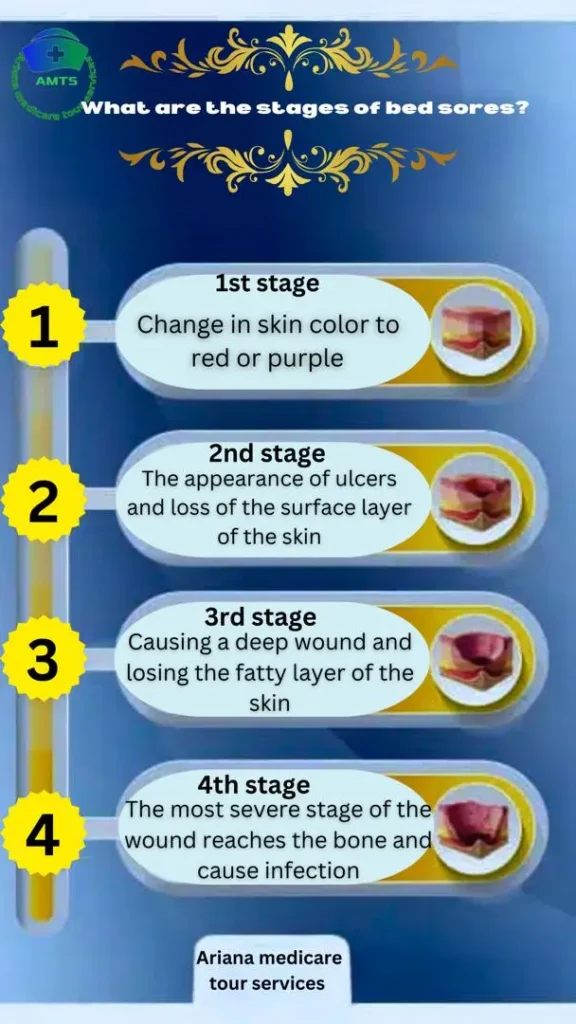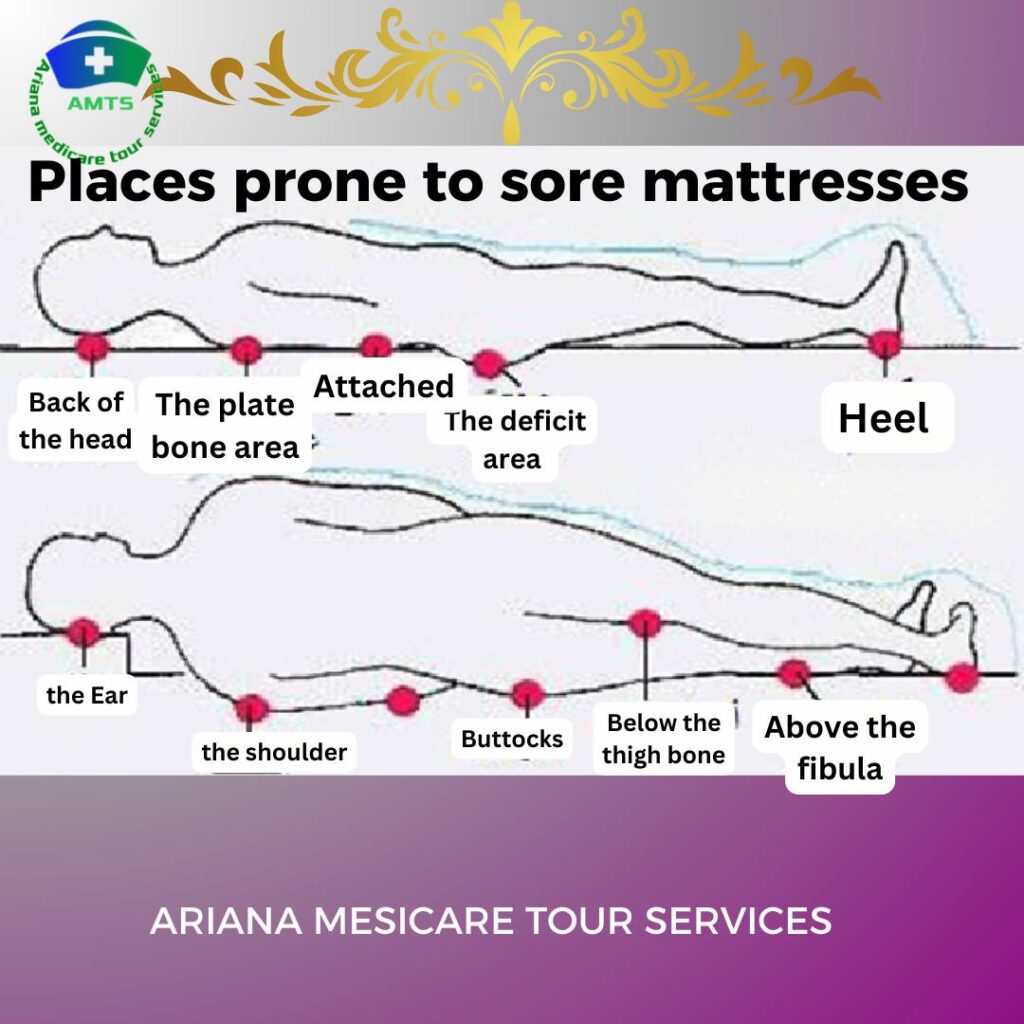A bedsore is an injury that occurs when pressure and force are applied to the skin over a long period. Several stages of damage have been identified for pressure sore disease, which can be treated and controlled if infection is prevented.
Bedsores are a painful and worrying problem for the elderly and patients who remain bedridden for a long time. Bedsores are often attributed to the elderly who are unable to move, but if a patient puts a lot of pressure on a particular area of his skin for a long time, his age does not matter.
The important thing in this disease is to prevent infection. Because if the wound becomes infected, the rest of the body will be at risk. Therefore, in this article, we will introduce you to the types of bed sores, their causes, symptoms, methods of preventing them, and methods of treating them at the hands of Ariana Company’s experienced doctors in Iran, in the city of Shiraz. Be with us

Table of contents:
What is bed sore disease?
- Cause of bed sores.
- Symptoms of bed sores.
- The first stage of pressure ulcer.
- The second stage of pressure ulcer.
- The third stage of pressure ulcer.
- Stage IV pressure ulcer.
- Who are the people at risk for pressure injuries?
- Risk factors.
- Complications of bed sores.
Management and treatment of bed sores
- Reduce pressure.
- Cleaning the wound.
- Change bandages.
- Don’t forget topical creams.
- Treatment of urinary incontinence in the patient.
- Removal of dead tissue.
- Use the appropriate bed and bed for the patient.
- Take all your prescribed medications.
- Follow a healthy diet.
- Consider surgical options.
- Can bed sores be
- prevented?
- last word.
- Frequently asked questions.
- Sources and sources
What is bed sore disease?
This disease, also known as pressure injury and pressure ulcer, affects and causes damage to an area of skin. In fact, when too much force and pressure is applied to a particular area of skin for a long time, it can damage it.
This force may consist of sustained pressure on the skin area or tensile pressure between the skin and another surface of the body (between the hips). If a pressure injury turns into a deep wound or a slow infection, it can be considered a life-threatening factor for the patient. Consult with us online through a free consultation.
Pressure sores can occur at different levels of the body, but in general the common areas that can be affected by pressure sores for a sitting person are:
- side.
- The coccyx.
- Spinal Cord.
- Their shoulders.
- Legs and back of arms.
A person who is constantly in bed can develop bedsores in the following areas:
- heel.
- Ankle.
- shoulders.
- The coccyx.
- Elbows.
- behind.
- The basin.
- side.
Cause of bed sores
Bedsore disease occurs when constant force and pressure damage skin tissue. In fact, these wounds occur when tissues and blood vessels are first compressed and then deviated. Because in this case, blood circulation will be very weak, and the only result will be tissue destruction and infection.
Causes of compression damage include:
- Pressure: When a patient remains in a fixed position for a long time, pressure on the skin can cause pressure ulcers.
- Cutting: Cutting pressure ulcers occur when a pulling force such as a bed moves up, but the patient’s body moves down. In this case, the body’s skin will stretch on the bed, and because of its sensitivity, it will cause damage to its internal structures.
- Moisture: Another cause of bed sores is moisture from sweat, urine, and feces, which can cause pressure sores by remaining on the skin and keeping it moist.
Symptoms of bed sores
Sometimes, pressure ulcers are caused by too much pressure in a short period of time or too little pressure in a long period of time. In both cases, the patient’s body must be monitored continuously to treat the symptoms and signs of bedsores.
Symptoms of the disease include:
- Discoloration: The affected area will appear blue or purple in dark skin and shiny, while light skin will appear pink or red. If the abrasive agent is removed from the skin and the color does not disappear for 10 to 30 minutes, there is a possibility of bed sores.
Texture changes: In most cases, the skin in the targeted area will feel firm, spongy, or warm.
Broken skin: If there is a superficial wound on a patient’s skin that contains fluid and pus and has an open head, this increases the likelihood of further damage to that area. In this case, the shallow wound enters the deeper layers of the skin.
Infection: A change in color and sensation around the edge of the wound, the presence of pus or green or black tissue around the affected skin, and the presence of fever in the patient are symptoms of ulcers resulting from infection.
If you have such symptoms, consult a dermatologist.
What are the stages of bed sores?

Four stages are considered to describe the severity of the wound in a pressure injury. How to diagnose bedsores will be done with the help of these four steps. After examining the patient’s skin and confirming the presence of pressure ulcers, the doctor assigns one of the stages of pressure ulcer to the patient. These steps include the following:
- The first stage of pressure ulcer
The first stage of bed sore disease begins with a change in skin color. The compressed area turns purple or blue in people with dark skin, and people with fair skin also suffer from redness in that area. This change in color occurs when the skin color does not return to normal through massage and finger pressure. - The second stage of pressure ulcer
At this stage, with the loss of the upper layer of skin, superficial damage occurs. Also, in some people, a lesion such as pimples appears on the skin, but we must say that the skin can repair itself at this stage. - The third stage of pressure ulcer
A relatively deep wound is created in the third stage of bed sores. These types of wounds are open and usually extend into the fatty layer of the skin. Although no muscles and bones are seen. - Stage IV pressure ulcer
The most severe stage of bedsore disease is assigned to stage IV. At this point, the wound has reached the surface of the bone and can cause inflammation of the muscles or bones. Lack of timely control and treatment at this stage may threaten the patient’s life.
Who is at risk for pressure ulcers (bed sores)?

- Anyone who remains in a fixed position for a long period of time is susceptible to this condition, but in general, pressure ulcers occur most often in people who need help changing their position.
People who can move in a limited way or have completely lost their ability to move. - Bedridden or wheelchair patients are at greater risk due to lack of mobility.
- Those who have a prosthetic limb. If the prosthesis is not positioned correctly, it will cause skin irritation.
- People who have lost sensation in part of their body. These people do not feel the pressure applied to their skin, and as a result, the lack of movement of the organ in question causes bedsores.
- Malnourished patients. If the body’s nutritional needs are not met, the wound healing process will be slow.
- Elderly patients whose skin naturally becomes thin with age (over 70 years) will be more sensitive as a result.
Risk factors for bed sores
The following factors can increase the likelihood of developing bed sores in susceptible people:
- incontinence.
- Your body mass index (BMI) is too high or too low.
- Very low weight (loss of cushion around the bone).
- Uncontrolled diabetes (reduces pain).
- Poor blood circulation.
- Lack of mental awareness.
Complications of bed sores
In general, complications of pressure ulcers include:
- Cellulitis: skin infection.
- Osteomyelitis: bone infection.
- Bacteremia: blood infection.
- Meningitis: Infection of the brain and spinal cord.
- Endocarditis: infection of the heart
Management and treatment of bed sores

If bed sore disease is in its early stages, the person can be treated at home. But remember that the pressure ulcer should be examined by a health care professional and based on his recommendations, pressure ulcer treatment measures should be taken.
Below, we will review useful strategies for managing and treating this disease:
1. Reducing pressure:
You can help the patient’s wound heal and prevent new pressure ulcers by constantly changing the patient’s position. It is also best to place foam pads or special pillows under the affected areas.
2. Cleaning the wound:
Gently wash minor wounds with soap and water. For open wounds, it is best to keep the affected area clean with the help of saline solution and bandage changes.
3. Changing bandages:
Dressing can protect bedsores and speed up the healing process. Therefore, it is best to choose a suitable bandage to wear based on your doctor’s recommendation. They include:
- Foam dressing
- Hydrocolloid dressings (wound protection)
- Hydrogel bandage (water gel)
- Alginate sauce (made from seaweed)
4. Don’t forget topical creams:
These creams have antibacterial properties and fight infections. On the other hand, topical creams can heal and protect damaged skin.
5. Treatment of urinary incontinence in the patient:
To do this, be sure to use detergents, barrier creams and special incontinence pads. You can also get help from stool management solutions for patients.
6. Removal of dead tissue:
In these cases, the doctor orders debridement, or removal of part of the dead tissue. This solution is considered one of the most important methods of managing and treating bed sores, which will improve the patient’s condition. In fact, with this treatment method, a chronic (long-term) wound becomes an acute (short-term) wound.
The method of treating dead tissue is:
- Ultrasound: Removal of dead tissue using sound waves
Irrigation: Washing dead tissue with pressurized fluids
Laser: Removal of dead tissue using focused beams of light
Biosurgery: Removal of wound bacteria and dead tissue with the help of bacterial worms
Ordinary surgery: restoration of dead tissue with the help of surgery and closure of the wound
Topically: regenerate dead tissue with the help of honey or medicinal enzyme ointments
7. Use the right bed and mattress:
Special mattresses for hospital patients help reduce pressure due to the presence of adequate foam. Also, the pump placed in some private beds can prevent bed sores and help them heal by circulating air.
8. Take your prescribed medications completely:
In severe cases, the doctor will prescribe antibiotics, which will be an appropriate option to heal skin, bone and blood infections.
9. Follow a proper diet:
It may not be possible to strictly monitor a specific diet as effective in treating and managing bed sores, but it can be said that consuming protein supplements helps in healing and reducing the size of the wound. In fact, consuming plenty of fluids such as water and nutrients can increase the patient’s overall health.
10. Consider surgical options:
When bed sore disease enters the fourth stage (the most severe type of pressure sore), the doctor suggests one of the surgical methods. In this method, healthy skin is usually used to repair dead tissue.
Can bed sores be prevented?

The way to prevent bedsores is not difficult. To do this, just carefully follow these steps:
- Change the patient’s position frequently (every 15 minutes to 2 hours) depending on the patient’s needs.
- Examine the skin of sensitive areas every day.
- Keeping the skin of sensitive parts of the body clean and dry.
- Planning the patient’s nutrition based on the appropriate and correct diet.
- Prevent smoking and any kind of smoking agents for patients in bed.
- In order to get proper blood circulation in the body, make sure to do proper exercises, especially for patients in bed.
- Avoid constant pressure on bony parts of the body.
- Use special pillows for patients in bed so that strong pressure is not applied to the bony areas of the body when they are turned over in bed.
last word
A bedsore is an injury to an area of skin caused by constant force and pressure on that part. In this disease, blood circulation is impaired and leads to the death of skin tissue. If a pressure injury is not recognized in time, it may cause the infection to penetrate into the deeper layers of the skin.
On the other hand, if you have bed sores, or suspicious skin lesions, especially in diabetics, contact us for treatment and advice.
Frequently asked questions about bedsores
- Are bed sores life-threatening?
This disease has four stages based on its severity. If the pressure injury reaches stage 4 (the most severe wound), it can pose a serious threat to the patient’s life due to infection. - How long does it take for bed sores to heal?
The recovery time from this disease depends on its severity and stage. If the disease is in the third stage (relatively deep open mouth-shaped ulcers), it takes about 1 to 4 months to heal. In some cases, it is necessary to remove dead tissue for complete recovery, and antibiotics will be prescribed to fight the infection. The duration of recovery in these stages depends on the doctor’s opinion and the patient’s body’s level of resistance
Sources
Black JM, Edsberg LE, Baharestani MM, Langemo D, Goldberg M, McNichol L, Cuddigan J (February 2011). “Pressure ulcers: avoidable or unavoidable? Results of the National Pressure Ulcer Advisory Panel Consensus Conference”. Ostomy/Wound Management. 57 (2): 24–37. PMID 21350270.
Padula WV, Black JM, Davidson PM, Kang SY, Pronovost PJ (June 2020). “Adverse Effects of the Medicare PSI-90 Hospital Penalty System on Revenue-Neutral Hospital-Acquired Conditions”. Journal of Patient Safety. 16 (2): e97–e102.
Read more about other articles in the medical fields (Cosmetics and Medical).
- Hair Transplantation in Iran
- Rhinoplasty (Nose Job in Iran)
- Face Lift Surgery (Rhytidectomy) in Iran
- Breast Lift in Iran
- Chin Surgery in Iran
- Liposuction in Iran
- Tummy Tuck (Abdominoplasty) in Iran
- Butt Augmentation (Brazilian butt lift)
- Breast Augmentation in Iran
- Eye Care in Iran
- Cataract Surgery in Iran
- Diabetic Retinopathy Treatment in Iran
- Heart Surgery in Iran
- Knee Replacement in Iran
- Eyelid Surgery in Iran
- Safe Abortion in Iran
- Fertility Treatment in Iran


